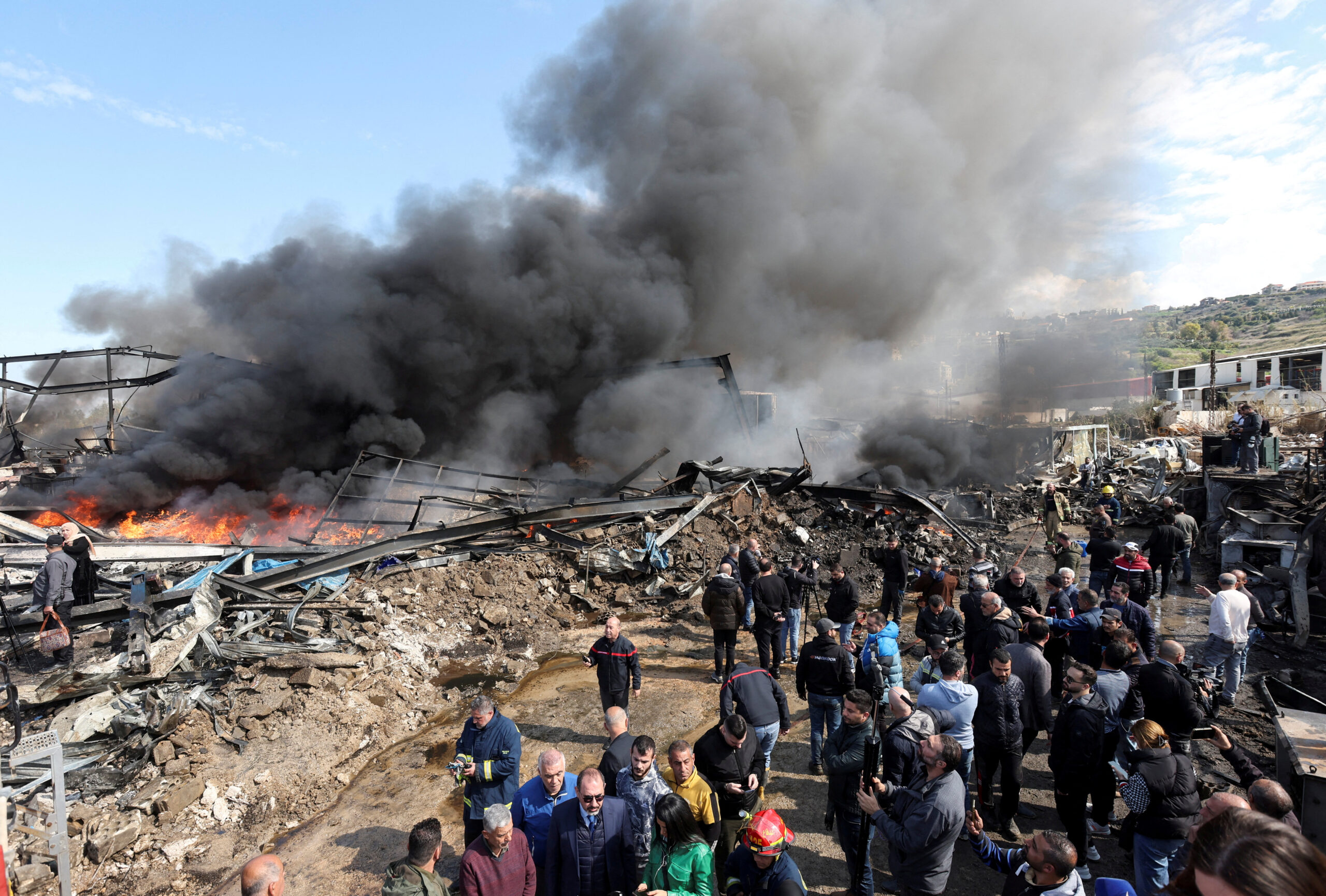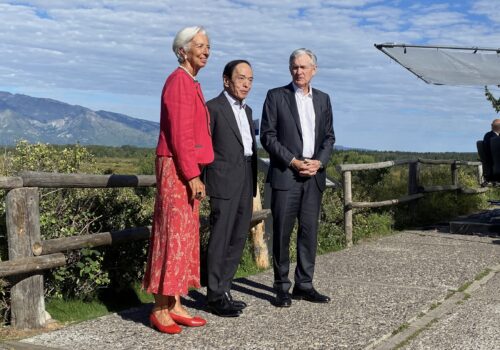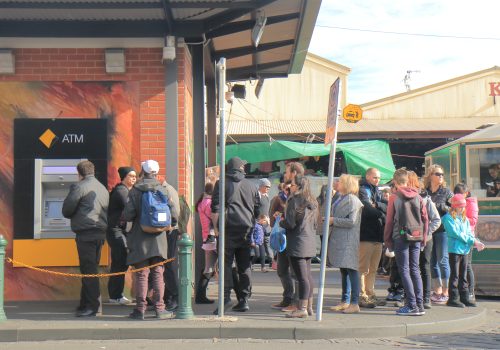Palestinians need a reimagined payments system to rebuild their economy
Rebuilding postwar Gaza will be a massive endeavor. A recent estimate by the United Nations puts the cost at twenty billion dollars, and it will require Israel, the United States, and regional stakeholders working together on a range of reconstruction efforts. In addition to renewed international pressure for a two-state solution and a broader rebuilding of physical infrastructure, transforming the financial architecture that connects Gaza, East Jerusalem, and the West Bank to the rest of the world should be a priority. Doing so can help establish a functional economy in the Palestinian territories underpinned by an effective and safe way for Palestinians to send and receive money.
The Palestine Monetary Authority (PMA), created by the Oslo Accords and established in 1994, serves as the central bank for the Palestinian territories and supervises the thirteen Palestinian and foreign banks operating in the West Bank and Gaza. However, unlike most central banks around the world, the PMA does not issue currency or conduct monetary policy. The de facto currency in the Palestinian territories is the Israeli shekel. Despite the obvious economic linkages between Palestinian territories and Israel, free movement of money between them is restricted. Following Hamas’s takeover of Gaza in 2007, many Israeli banks cut off or reduced correspondent relationships with Palestinian banks due to concerns about money laundering and terrorist financing, pushing the Palestinian economy to an even more cash-based system. This, in addition to limited shekel clearing by Israel, leads to excess shekel holdings in Palestinian banks.
Ironically, cutting off the connections between Israeli and Palestinian banks due to concerns about money laundering and terrorist financing has created significant vulnerabilities that enable terrorist financing. Limited infrastructure (twenty-three ATMs per one hundred thousand people in 2021), limited access to banking, a lack of financial literacy, and inconsistent sources of income make the reliance on cash even more acute within the Palestinian territories, especially the West Bank. Cash can be anonymous and opaque, making it a preferred vehicle for illicit actors, including terrorists, to raise, use, and move money.
Overreliance on cash also creates challenges for the general population as it is difficult to track, is not secure, and is difficult to hold in large quantities. With excess shekel holdings, Palestinian banks are unable to create capital, and bank profits are lowered by 20 percent. Due to blockades and checkpoints, cash needs to be physically moved into and out of Palestinian territories, which adds time, costs, and opportunities for corruption. Adding to this, concerns about money laundering and terrorist financing, especially in the West Bank, have prevented many Palestinians from opening and maintaining bank accounts, limiting their access to the international financial system and markets.
Even before the war, 80 percent of Palestinian residents were largely reliant on international aid and remittances, and this reliance will likely only increase due to the war. The financial plumbing that is required for the flow of money into the region is broken.
Over time, Israel has tried to solve these issues. Before October 7, Israel’s goal was to keep the situation in the West Bank and Gaza at what it called “a low simmer.” The view was that Hamas was focused on governing the Gaza Strip, not undertaking terrorist attacks. And so, with the knowledge of the United States, Israel engaged in a policy intended to allowed Hamas to receive just enough financial support to keep things from boiling over. In 2016, the Israeli government entered a deal with Qatar to prevent a cash crunch in Palestinian territories. Every month, Qatar would send cash valued up to fifteen million dollars to Gaza, meant for public servant salaries and humanitarian aid, a portion of which was diverted to Hamas, which controlled the government and taxed residents. The Israeli and US governments have known about this, along with other sources of Hamas’s funding, for years before Hamas’s October 2023 attack. Over time, the territories’ increased reliance on cash exacerbated Hamas’s other extraction capabilities—cash is relatively untraceable and easy to siphon into seemingly legitimate businesses. In the past, aid money from Turkey, Iran, and Egypt flowed through Hamas, which continues to have direct and indirect sources of income in the region.
A better financial architecture is needed in the Palestinian territories to facilitate the movement of money for the needs of Palestinians, while preventing siphoning to terrorist groups such as Hamas and other illicit actors. While a range of financial improvements are needed, including expanding financial access and literacy, it also makes sense to look at digital finance as a tool of reconstruction, including the possibility of a shekel-backed stablecoin, based on blockchain technology.
What stablecoins can do
Unlike cash, a stablecoin can be traceable and provide transparency into money flows into the territories. As the name suggests, a shekel-backed stablecoin will need shekel reserves, which Palestinian banks have in abundance, but it will not rely on the movement of physical cash. Coupled with a strong process to stop money laundering and terrorist financing, the stablecoin could be held in digital wallets or physical cards. Such a stablecoin could overcome two big problems faced by Palestinians today. First, it would make direct access to money easier and less reliant on physical cash. Second, it would enable tracking and tracing of money to ensure that siphoning to Hamas and its affiliates can be prevented. It could still do this while ensuring the privacy of transactions and enabling trust in the system. A stablecoin would be faster, cheaper, and safer than the alternatives currently in use in Gaza.
A stablecoin alone will not solve the financial infrastructure and access issues of the Palestinian territories. Even before the war in Gaza, only 80 percent of the population had access to the internet, and updated broadband will be required to enable a mobile-based banking system. (Currently, only 3G access is allowed in Gaza and 2G in West Bank.) More than 80 percent of the population has access to a mobile phone, but just 2 percent has actually made a purchase with one. Electricity shortages were common before the war, and have gotten worse since. Access is not the only issue. Individuals with low and inconsistent streams of income will have to be encouraged to use a new system, and trust will have to be built into that system. Any new technology will have to come with financial literacy and training efforts.
Fortunately, there are several existing examples of post-conflict reconstruction of payments systems. When Russia launched its full-scale invasion in 2022, Ukraine was already in discussions to build a central bank digital currency and further digitize its economy. Since February 2022, both private and public institutions have partnered to provide solutions to enable the movement of aid into Ukraine and build a domestic payments infrastructure to enable e-hryvnia, a hryvnia-backed stablecoin. A similar solution has been put to use in Afghanistan, which, with sanctions on the Taliban, has similar attributes to the situation in Gaza. In 2022, an afghani-backed stablecoin was distributed through HesabPay, using the Algorand blockchain. Research has found that direct aid distributed through HesabPay met humanitarian needs while preventing leakages to the Taliban and ensuring low costs.
A shekel-backed stablecoin could be part of the solution to an emerging humanitarian crisis, as well as a building block to the future of payments in Gaza and other war-torn territories.
This reorientation of the financial infrastructure in the Palestinian territories will require US and EU engagement with the PMA and Israel. It will also require working with regional partners, such as Qatar, the United Arab Emirates, Turkey, Saudi Arabia, and the broader Gulf Cooperation Council. It will involve collaboration with the intergovernmental Financial Action Task Force, which can continue its ongoing reviews and accreditation to keep the PMA compliant with regulations to combat money laundering and terrorist financing. As multilateral institutions provide aid and technical support to the Palestinian territories, they must prioritize projects like this one, which aims to be economically sustainable and ultimately productive. This could provide an opportunity for positive international collaboration that provides long-term benefits for the Palestinian territories and the broader region.
Ultimately, the success of a shekel-backed stablecoin or any other project will depend on a host of regulatory and policy improvements that the PMA and other institutions will be responsible for. A functional and sustainable Palestinian economy requires a functional payments system, and that will be to the benefit of the wider region.
Ananya Kumar is the associate director for digital currencies at the GeoEconomics Center. She leads the Center’s work on the future of money and does research on payments systems, central bank digital currencies, stablecoins, cryptocurrencies, and other digital assets.
The author thanks Kim Donovan and Jonathan Panikoff for their contributions to this piece. Ryan Murphy also contributed research.
Further reading
Wed, Feb 21, 2024
A steady escalation along the Lebanon-Israel border—and no end in sight
MENASource By Nicholas Blanford
If the Gaza war drags on for much longer and clashes continue to persist along the Lebanon-Israel border, the pressure on the Israeli government to launch some form of offensive into south Lebanon is going to be hard to resist.
Thu, Jan 25, 2024
The Fed is falling behind as other central banks leap ahead on digital currencies
New Atlanticist By Josh Lipsky, Ananya Kumar
And the innovation gap is not just on CBDCs. FedNow, the long-awaited interbank settlement system, has taken years longer than comparable systems in Europe.
Thu, Nov 2, 2023
Asking the right questions: Can digital currency enable financial inclusion?
Issue Brief By Ananya Kumar
Cryptocurrencies and CBDCs have the potential to enhance financial inclusion. However, the lack of quantitative data makes it challenging to evaluate their impact. To assess their financial inclusion capacity, this paper builds a rubric for policymakers which includes layers of consideration.
Image: Palestinian women walk past a money changer in the West Bank city of Ramallah February 16, 2010. The Palestinians do not have their own currency. The dollar and the Jordanian dinar are both used for some transactions, though the Israeli shekel is most commonly handled in day-to-day cash transactions. REUTERS/Mohamad Torokman


